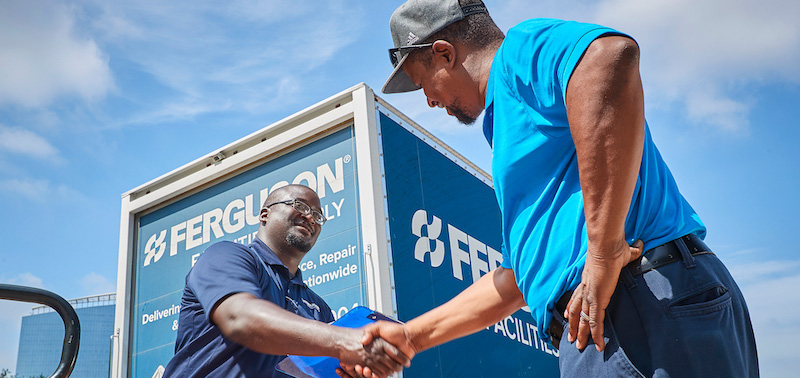Editor’s Note: This is the first in a three-part Premium series analyzing Ferguson Enterprises and its transformative growth journey in North America. See Part 2 here, and stay tuned for Part 3.
Ferguson is the leader in channel expansion in North American construction and industrial distribution.
The company has steadily grown into one of the largest distributors in North America over the past 20 years. Now separated from U.K.-based Wolseley plc, Ferguson’s roots were in plumbing, but the company has evolved to become a company with $30 billion in annual revenue that has expanded into multiple industrial supply channels.
I have been terming this trend of distributors that enter new channels as “channel drifters.” To me, a channel drifter is a distributor that started in one distinct channel and was predominantly linked with one industry association such as NAED, ISA, HARDI, ASA, etc. At some point, this distributor entered another channel (usually through acquisition) and this drift was often to a similar, adjacent channel like plumbing is to PVF/waterworks or HVAC.
In the MDM Store:
– Case Study – Wesco: Strength through Scale, People and Digital
– Case Study – Fastenal: The Big Pivot that Paid Big Dividends
Ferguson is, in my opinion, the most successful of these “channel drifters” and now is a channel leader in many distinct channels — plumbing, HVACR, residential remodel, waterworks, fire protection, industrial supplies and more.
This is exemplified by MDM’s 2024 Top Distributors Lists, on which Ferguson appears seven times. Based on its fiscal 2023 revenues within each sector, Ferguson ranked No. 1 on Plumbing; No. 2 on HVACR, No. 2 on Industrial PVF; No. 3 on Industrial Supplies; No. 3 on Building Materials/Construction; No. 9 on JanSan/Packaging/Disposables; and No. 11 on MRO.
I have worked for and with Ferguson veterans and have been an avid observer of the company’s continued growth. Ferguson has undergone aggressive expansion both organically and via numerous acquisitions across multiple distribution channels.
If you are in construction and/or industrial supplies distribution, you are probably competing with Ferguson on some level today, and if you are not, there is probably much to learn from how the company approaches its various markets.
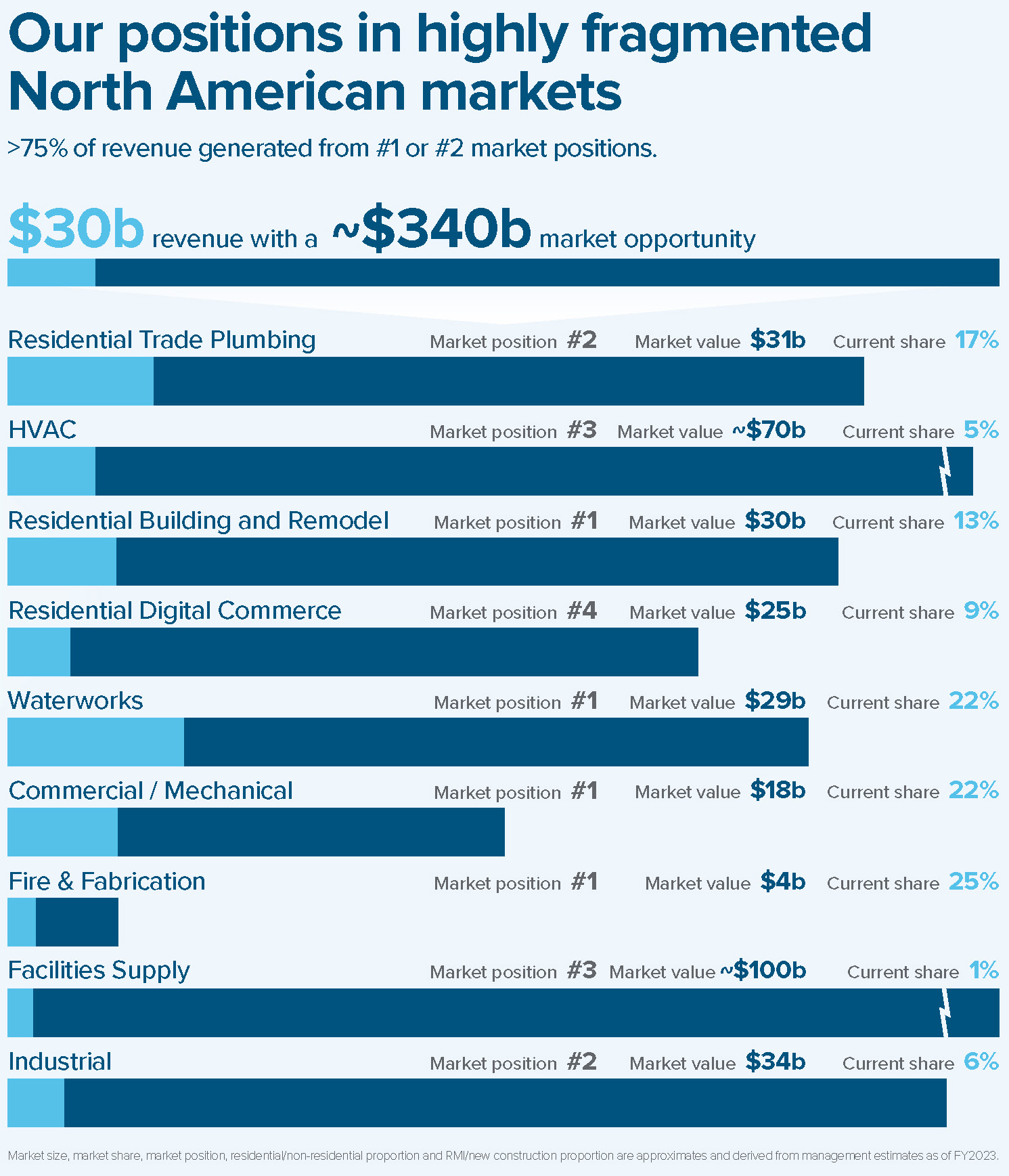
The above graphic from Ferguson’s 2023 Annual Report highlights the company’s estimated market position and potential by channel. This graphic and market-by-market available data is unique to Ferguson as a publicly-traded North American distributor. Fastenal, Grainger, Wesco, MSC Industrial, ADI and others do not similarly report market share and total addressable market available in each of the different channels they serve. What strikes me is Ferguson’s diversification (nine channels) while remaining focused on the customers they serve.
In its fiscal 2023 — which ended July 31, 2023 — Ferguson achieved just shy of $30 billion in annual sales in an estimated $340 billion North American market on the strength of its more than 1,700 branches and 35,000 associates from coast to coast in the United States and Canada. At its core, Ferguson is a branch-based distributor that has material placed close to the end customers and construction projects that rely on its products and services.
As the old distribution mantra says, Ferguson is serving its end customers with an approach that delivers “What you want, where you want it, when you want it, at an agreed-upon price.”
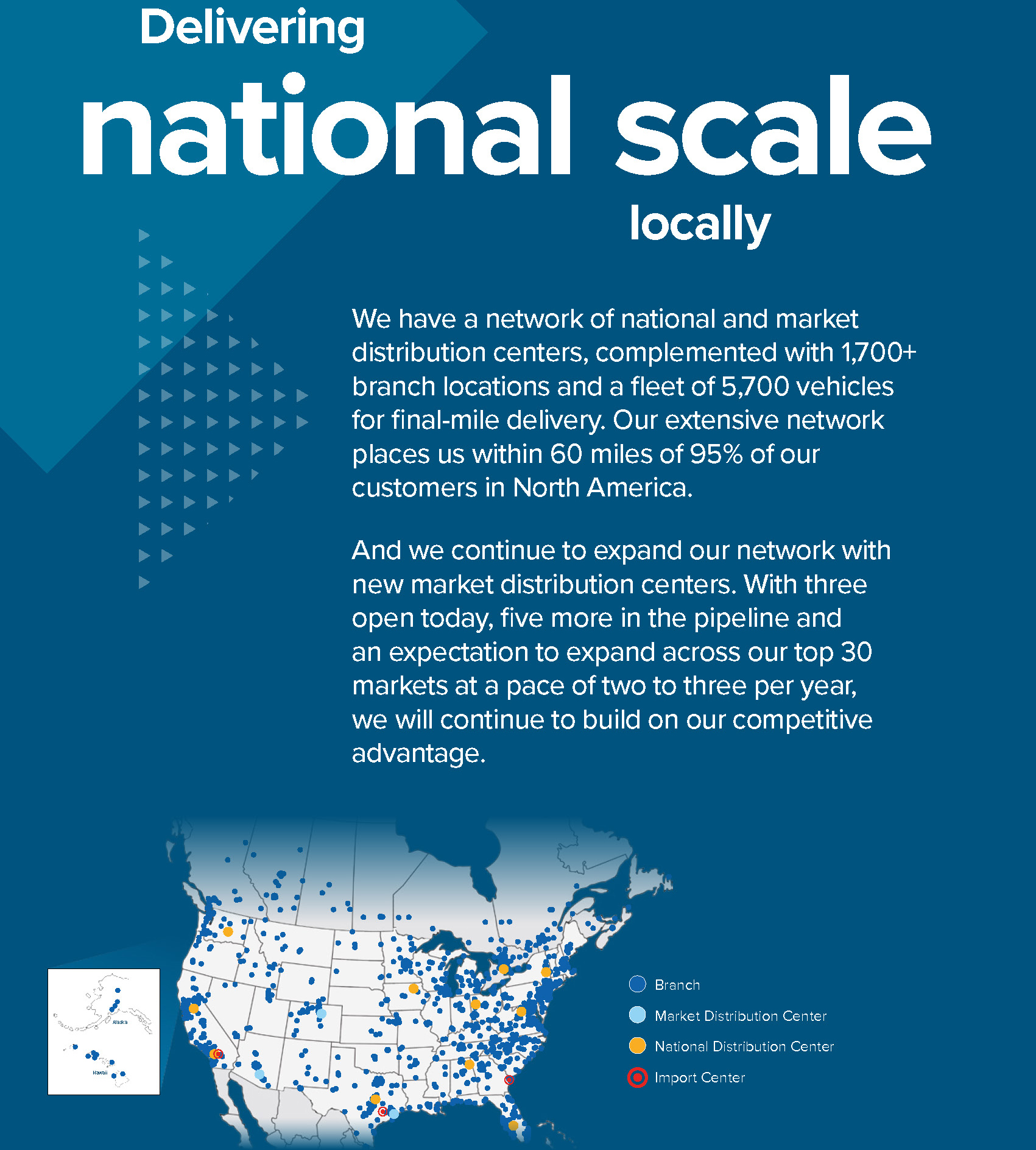
This Ferguson graphic shows the company has inventory placed within 60 miles of 95% of its end customers, supported by market and national distribution centers and import centers.
The company’s distribution network (branches and DCs) occupied nearly 57 million square feet with $3.9 billion total inventory value as of July 31, 2023. Its fiscal 2023 sales-per-square-foot were roughly $524, and the sales-per-employee-ratio was close to $850,000.
Ferguson is a distributor that excels in serving a customer base largely comprised of contractors. Of course, it also serves end user industrial customers like Fastenal and Grainger do, but most of its business is contractor-based.
Being a contractor-focused distributor requires same-day inventory near where the customer does new construction and remodel work, supported by next-day inventory.
You can’t become a $30 billion distributor without excelling at delivery and support while having local and next-day inventory, so Ferguson obviously performs well in those areas.
How is Ferguson’s Branch-Based Model Evolving?
The end customers Ferguson serves are evolving and changing, and the company is likewise adjusting to that change.
1. The Residential Market is Evolving
Ferguson estimates that $30 billion of the $100 billion addressable residential trade plumbing and HVAC market is being served by dual-trade plumbing and HVAC professionals.
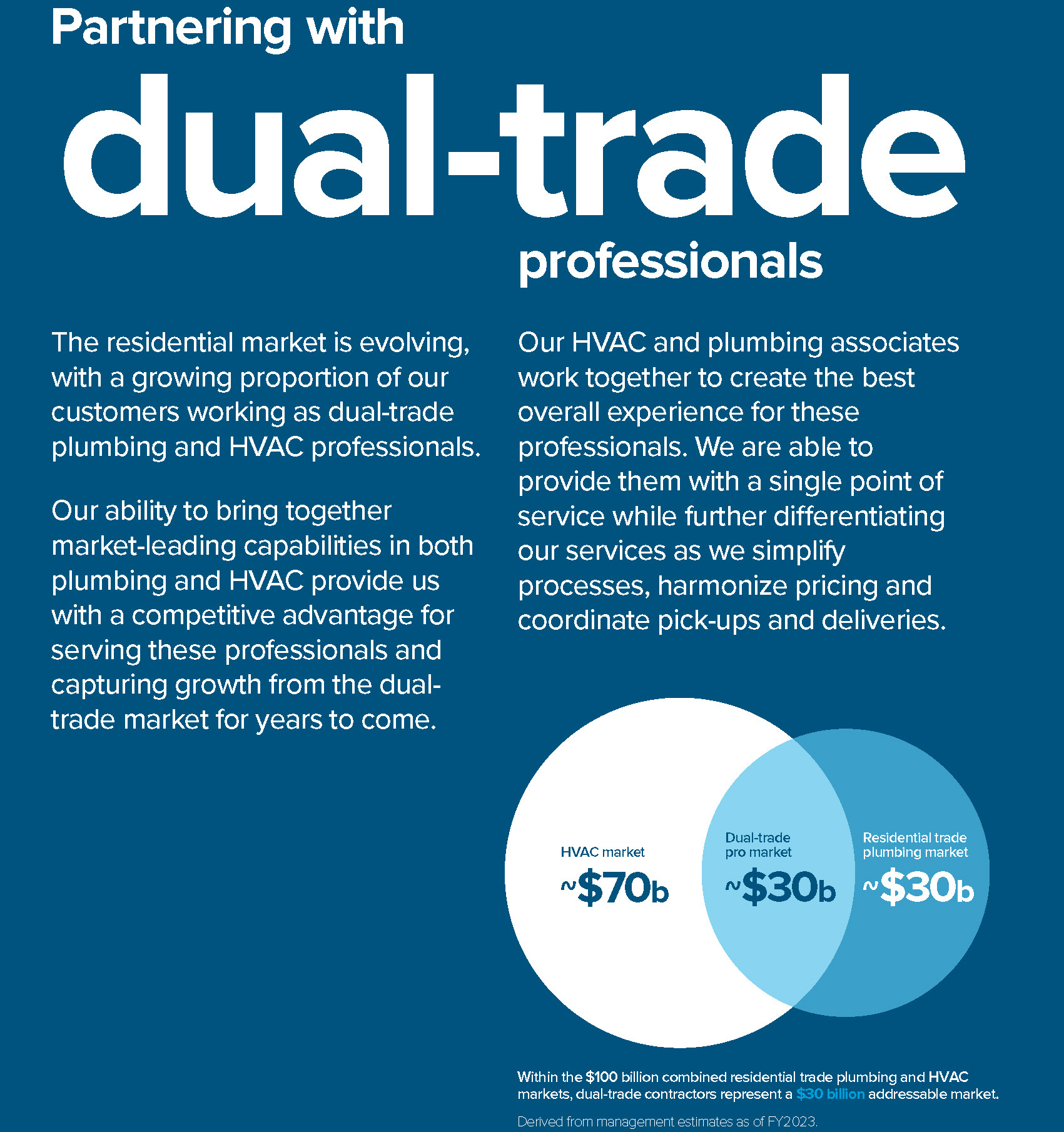
Ferguson has adjusted to this customer change with its acquisition strategy. Ferguson has made more than 50 acquisitions in the last five years — including 10 in its fiscal 2024 — and in my opinion, it has strategically chosen acquisitions in part to serve this changing dual-trade contractor. The same trend is also happening in commercial construction.
When you look at many of Ferguson’s acquisition announcements over the past two years, this focus on the dual-trade contractor is apparent. Here are two recent announcements that stood out.
“S. G. Torrice is a distributor of HVAC equipment, parts and supplies in the New England region. Founded in 1958, it is headquartered in Wilmington, MA and has 15 locations in Maine, Massachusetts, New Hampshire, Rhode Island and Vermont. With the closing of this previously announced acquisition, Ferguson can further serve dual-trade plumbing and HVAC professionals in the New England region.” — Aug. 2, 2023 news release
“Airefco, joining Ferguson will support our dual trade strategy for the plumbing and HVAC contractors and will help us accelerate the geographic expansion of our HVAC business in the Pacific Northwest. It will also provide us with a larger multi-brand footprint and an opportunity to expand the Carrier network in the region’s growing residential and commercial markets.” — Kevin Murphy, Ferguson CEO in Dec. 2, 2022 news release.
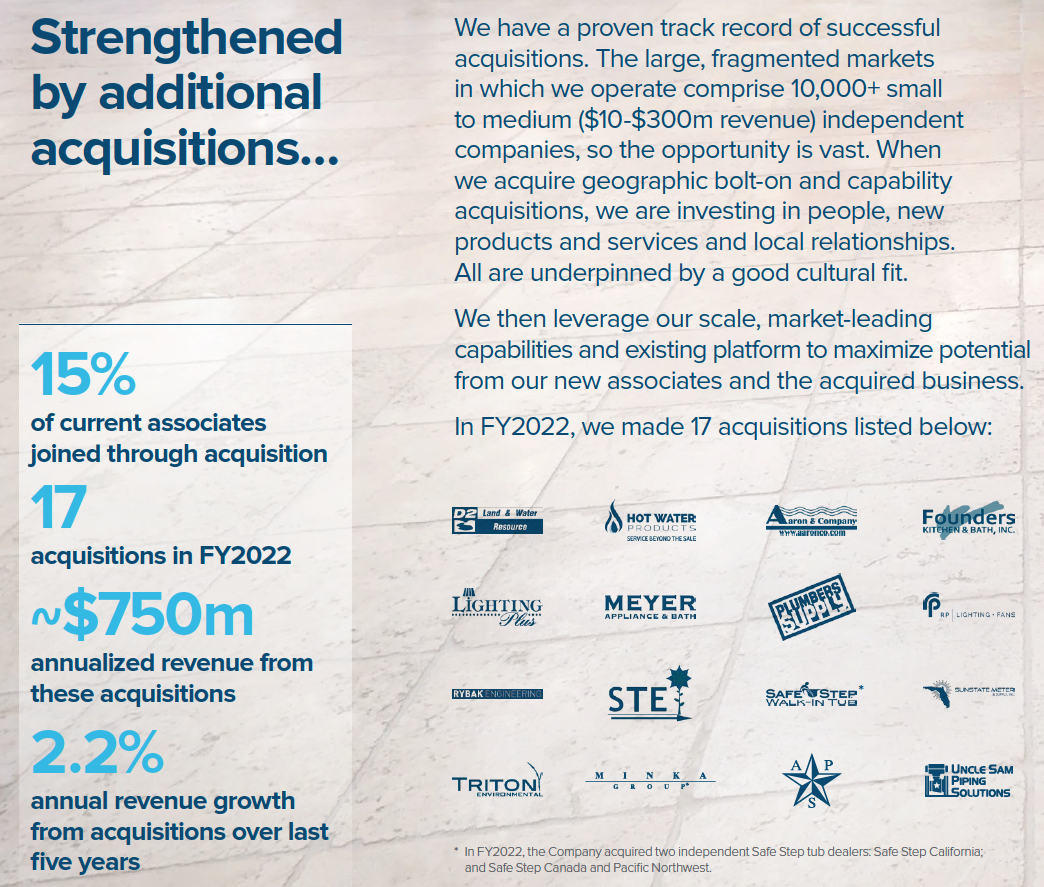
This Ferguson graphic from its 2022 annual report gives more detail on the company’s acquisitions. As noted earlier, the aggressive pace continued throughout its fiscal 2024 Ferguson with another 10 deals closed. If you project out from the above 2022 statistic to today on 15% percent of associates joining through acquisition, it is possible that close to 20% of all Ferguson associates have joined the company as an acquisition.
2. Ferguson Continues to Evolve its Support and Fulfillment of End Customers
It is rare to find a company that shares public data on how it serves and fulfills customers by order type, but Ferguson’s 2022 annual report (released Oct. 27, 2022) and a January 2022 investor day presentation shared some information about order fulfillment that I found fascinating.
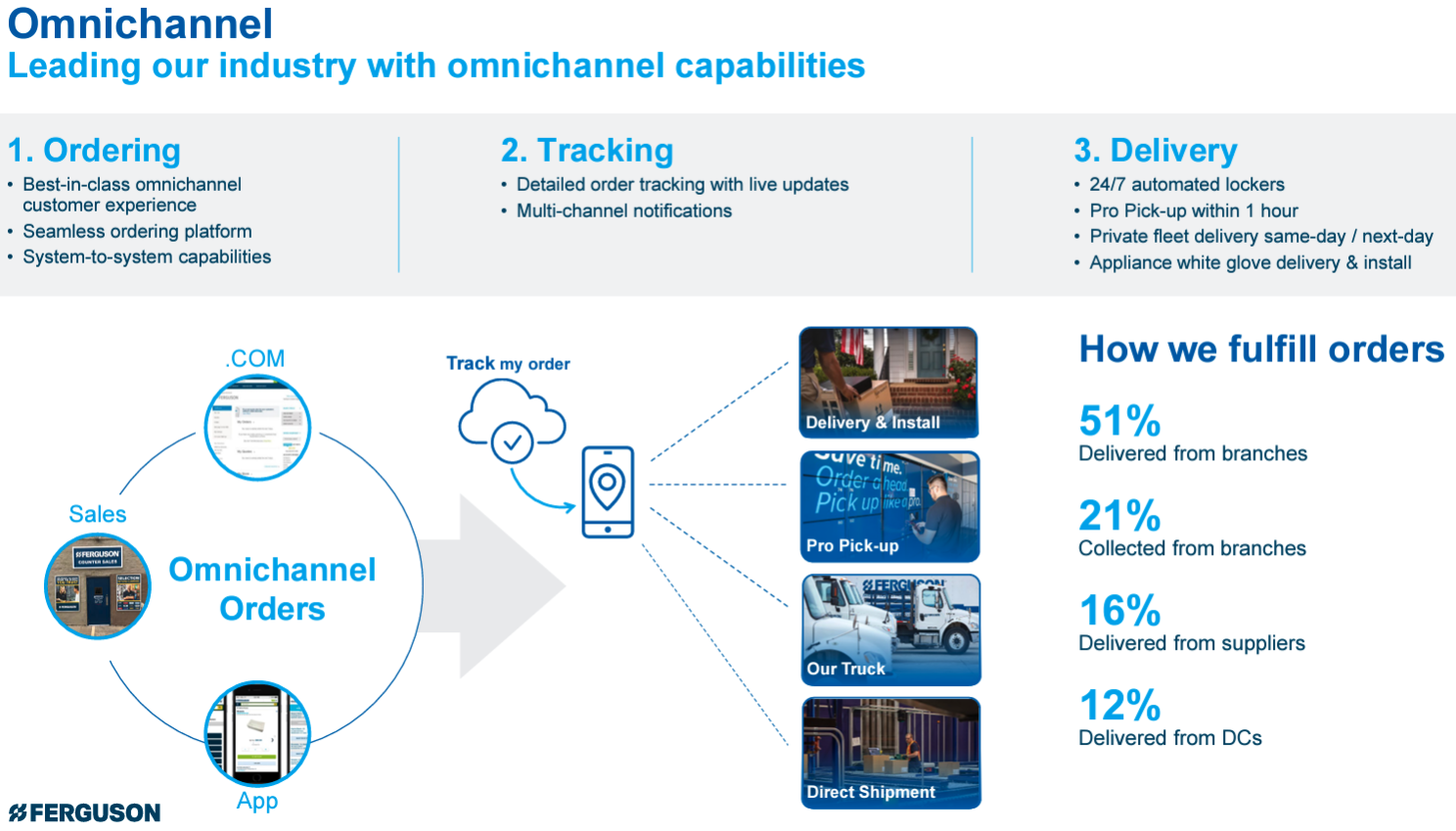
I find the “How we fulfill orders” stats very interesting. I suspect these numbers may have moved slightly since that presentation.
The order control that Ferguson has is at a high level, with only 16% of orders sent as direct shipments from its suppliers (please note these are order volume stats, not order value/percentage of sales).
Ferguson has added additional distribution center support to evolve this level of fulfillment. The why behind Ferguson’s delivery support evolution is apparent in the graphic. As customers are evolving how they order, how they want to track it and how they need the product delivered, Ferguson is changing its support in lock-step.
3. Ferguson Understands How and Why its Customers Buy from it
In 2022, Ferguson released the following data point:
“How customers buy from us” (% of group revenue)
- 68% in branches
- 21% via eCommerce
- 11% in showrooms
In later parts of this series, we will dive deeper into the eCommerce numbers and their impact. What I found interesting about the above statistics isn’t just the level to which Ferguson is tracking how customers buy. While the majority of its orders are branch orders (call-, email-, counter-type orders), eCommerce and showroom orders combined account for nearly one-third of the total.
What this indicates to me is that as eCommerce orders grow — and they likely have since this number has been published based on the buying trends we’re seeing elsewhere in the industry — Ferguson will always be close enough to its customers to have the right tools developed to meet their needs.
So, What Can You Take Away from this Part of the Ferguson Story?
Channel drifting can be a very effective approach to growth. Understanding how and why your customers buy and changing your business to meet those needs leads to growth.
In my opinion, the information Ferguson has released shows that it has a deep understanding of data and excellent customer research. Ferguson has nine channels identified and a detailed market share and total addressable market estimates for each of them. The only way to do that work is to have a data focus. It also indicates that Ferguson is surveying and getting feedback from its customers, associates and supplier partners on how to continuously serve end customers better.
The questions of “What tools do our customers need today?”; “What tools will our customers need tomorrow?”; and “How can we develop better tools and support to take share from the competition?” are all likely part of the Ferguson mantra. I imagine those words or some similar version are probably written on a strategy whiteboard at Ferguson’s headquarters in Newport News, VA.
Does your strategic messaging reflect the same?
